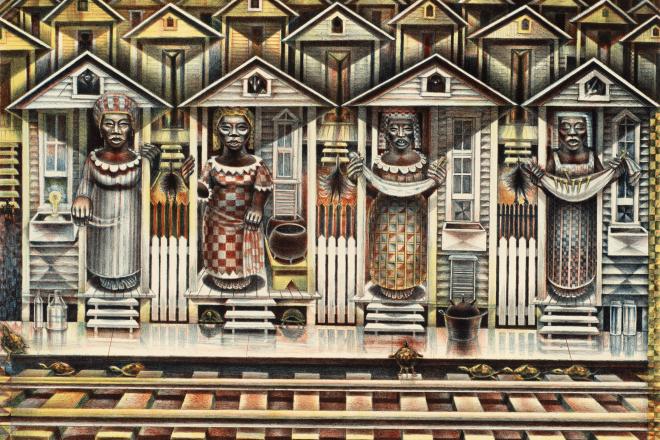Confucius says that anyone who can learn something new by reviewing what he knows already is prepared to be a teacher. Witold Rybczynski seems to have done this, and he dedicates How Architecture Works (Farrar, Straus and Giroux, 2013, 335 pages, $27.00) to the students in his freshman seminar.
So, how do we read it? My bet is that someone is going to begin a review of it by saying it is, therefore, a book for both the general reader and the professional architect, as though it’s both a primer and a summary. But I wonder if it’s possible for any book like this to be equally useful on two very different levels. I’ve asked myself if there is a book of practical literary criticism I’d recommend to friends who are serious readers, and I can’t think of one off-hand.
I’m not an architect, but not the general lay reader either. I’m an interested party who has read four of Rybczynski’s other books. His basic principle in How Architecture Works is that “most of us lack a conceptual framework for thinking about the experience of architecture.” It’s important to agree that any art has to be an experience first, before its meaning can be developed within an understanding of the art’s conventions, and then within the history and theories that make up the professional discourse around it. Rybczynski says, however, that architects are rationalizers and apologists, critics are partisans, and architectural terms --- like “squinches and ogee curves” --- are too obscure. He says that architecture itself should speak to all of us: “You shouldn’t need a phrase book or a user’s manual.” That is, no conventions. But he subtitles his book A Humanist’s Toolkit, which sounds to me like code for a user’s manual that is emphatically not a theory, and he includes a glossary with terms that range from “classicism” and “revival” to “esquisse” and “metope.” The general reader who picks up this book probably understands the first two terms, but only the architect, who doesn’t need the first two definitions in the first place, understands the second two.
This, in a nutshell, is the problem of the two audiences.
The problem is also evident in the different chapters he writes on “ten essential topics of architectural concern” and the different ways architects address them. These are “Ideas,” “The Setting,” “Site,” “Plan,” “Structure,” “Skin,” “Details,” “Style,” “The Past,” and “Taste.” Are all of these as “essential” as he says they are and as transparent as they seem? Or is he proposing an agenda? What would a counterproposal be? The professional readership can obviously answer these questions more readily than the amateurs can. And although all the chapters are filled with famous names and examples, architectural principles and their variations, history and interesting anecdotes, there are not enough pictures for a reader who doesn’t know all these buildings and hasn’t stood in front of them. Scale and proportion are not among his 10 essential topics; but I know, and not from reading, that you have to judge scale and proportion in person by measuring buildings with yourself, as you stand and look and then move through them.
“Ideas” is one of the most satisfying chapters because ideas have to exist in language. “Plan” is difficult because architectural plans are not easy for me to read, and I doubt that I’m alone in this. “Details” such as balustrades are not as compelling as ideas, and “Structure” has a lot about concrete. These are chapters I would have to study. The issues of style and taste, however, and the role of the past are common to literature and even to life.
In “Ideas,” he writes first about the great dome of the Pantheon in Rome, “one of the most influential buildings of Western architecture,” and its influence on Bramante’s St. Peter’s, Wren’s St. Paul’s, and Walter’s dome in the U. S. Capitol. Wright’s idea for the Guggenheim Museum is the next one he mentions (he likes the Guggenheim), then Mies van der Rohe’s and Philip Johnson’s different ideas for their glass houses. These ideas do not seem as influential as the dome of the Pantheon, and Rybczynski makes much of the fact that the glass houses don’t have screens to keep mosquitoes out. The “most famous concept house in history,” he then writes, is Palladio’s Villa Rotonda. My guess is that there are more Palladian houses than there are public buildings with great domes. Does this make any difference to his argument? When Rybczinski gets to a discussion of the curtain wall, about 100 pages later in the chapter “Skin,” I’m thinking that the curtain wall is at least as influential as the Pantheon’s dome and probably much more frequently used. But I don’t know enough to begin with and don’t learn enough here to decide.
“Style” is an abstraction that is sometimes a signature, sometimes a limitation, or both. It is, however, not exactly the “style” that develops as a “coherent visual logic” in a particular building or the one that develops as the solution to a problem. All of them, nonetheless, have to be defined within the canon of conventions that make architecture a profession and, to the unknowing layman, may also make the markers of a style invisible. I like this chapter, in any case, because it discusses many examples and a lot of opinions. “The Past” has a wide range too. I finally learned what London’s Cenotaph is and read again the thrilling story of Maya Lin’s Vietnam Veterans Memorial, which came in line after his stories of the Lincoln Memorial and the Gateway Arch.
In 2007, the AIA commissioned a poll that asked the American public to name its favorite buildings. The top five were The Empire State Building, the White House, Washington National Cathedral, the Jefferson Memorial, and the Golden Gate Bridge (which we can all agree has been built but is not a building). I’m surprised the Cathedral is third on the list and surprised the Biltmore Estate is included in the second five with the Lincoln Memorial --- my choice over the Jefferson --- and the Chrysler Building --- my choice over the Empire State Building. Rybczynski is eager to emphasize that the Vietnam Veterans Memorial is the only contemporary “building” in the top 10, which is very gratifying. I’m left wondering, however, how much influence photography has had on the list. I can’t picture the National Cathedral, which I have been to, but not seen very often in pictures, and I’ll bet there are more images out there of the Empire State (with and without King Kong) than there are of the Chrysler Building. But then where on the list is Rockefeller Center, which NBC shows us all the time?
How Architecture Works may be more like the sophomore survey than the freshman seminar and most valuable for the other books and courses it calls for, which can focus more tightly on the issues and debate their values more thoroughly. Still, I know I’ll keep Rybczinski’s book on hand to re-read parts I didn’t get and re-think parts I assume I did. It’s a more provocative book than introductions usually seem.
More >>>
Read Terrence Doody on A Culture of Cities by Vishaan Chakrabarti.










